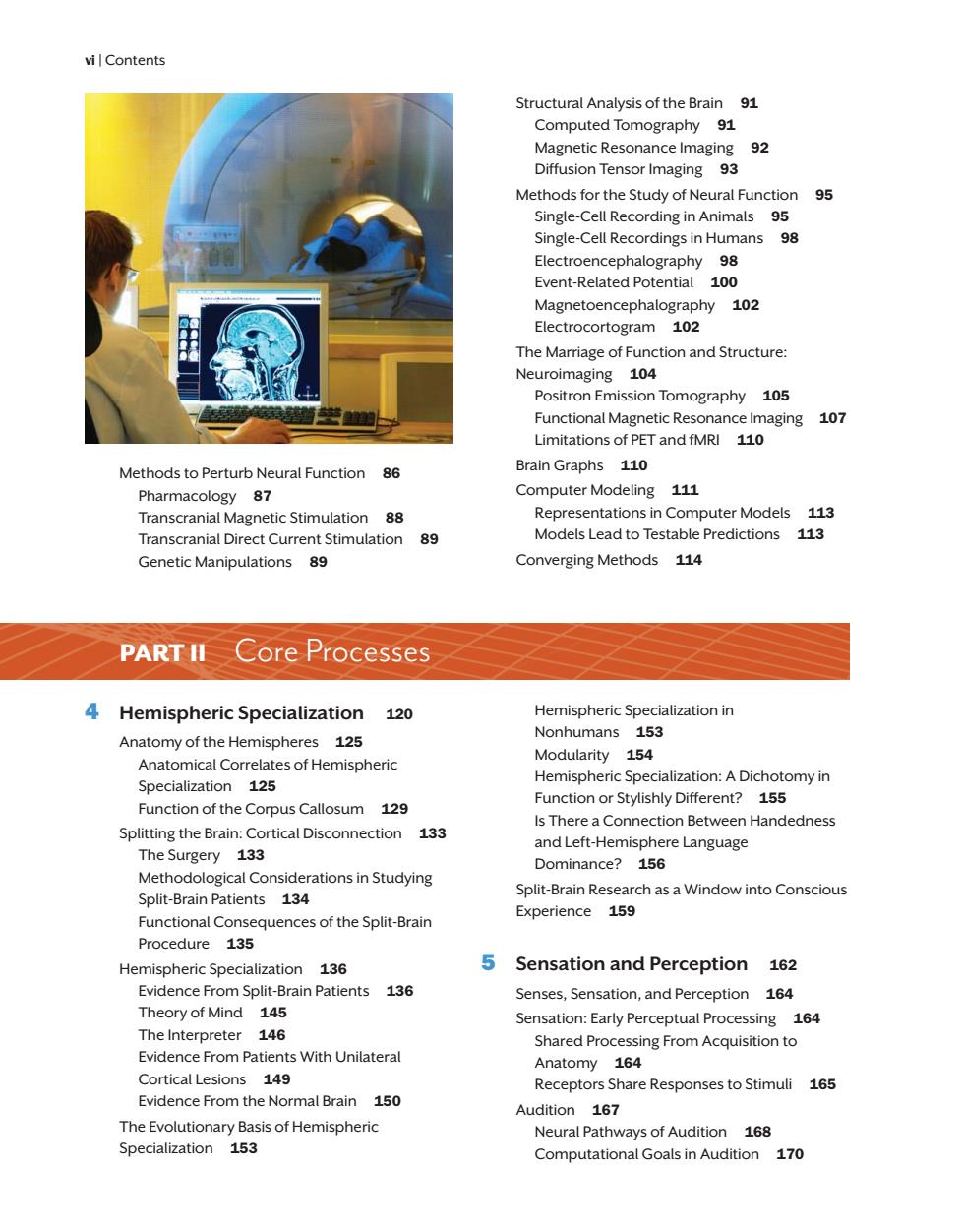正在加载图片...

vi Contents Structural Analysis of the Brain 91 Computed Tomography 91 Magnetic Resonance Imaging 92 Diffusion Tensor Imaging 93 Methods for the Study of Neural Function 95 Single-Cell Recording in Animals 95 Single-Cell Recordings in Humans 98 Electroencephalography 98 Event-Related Potential 100 Magnetoencephalography 102 trocortogram 102 The Marriage of Function and Structure: Neuroimaging 104 Positron Emission Tomography 105 Functional Magnetic Resonance Imaging 107 Limitations of PET and fMRI 110 Methods to Perturb Neural Function 86 Brain Graphs 110 Pharmacol Computer Modeling 111 lagnetic Stimulation 88 Representations in Computer Models 113 anscranial Direct Current Stimulation 89 Models Lead to Testable Predictions 113 Genetic Manipulations 89 Converging Methods 114 PART II Core Processes 4 Hemispheric Specialization 120 Hemispheric Specialization in Anatomy of the Hemispheres 125 Nonhumans 153 Modularity 154 Anatomical Correlates of Hemispheric Hemi Specialization 125 ialization:A Dichotomy in Function of the Corpus Callosum 129 Function or Styishly Different?55 re a Connection Between Handedness Splitting the Brain:Cortical Disconnection 133 The Surgery 133 and Left-He Methodological Considerations in Studying Dominance? Split-Brain Patients 134 Split-Brain Research as a Window into Conscious Experience 159 Functional Consequences of the split-Brain Procedure 135 Hemispheric Specialization 136 5 Sensation and Perception 162 Evidence From Split-Brain Patients 136 Senses,Sensation,and Perception 164 Theory of Mind 145 Sensation:Early Perceptual Processing 164 The Interpreter 146 Shared Proc ing From Acquisition to Evidence From Patients With Unilateral Cortical Lesions 149 Anatomy 164 Receptors Share Responses to Stimuli 165 Evidence From the Normal Brain 150 Audition 167 The Evolutionary Basis of Hemispheric Neural Pathways of Audition 168 Specialization 153 Computation Goals in Audition 10vi | Contents 4 Hemispheric Specialization 120 Anatomy of the Hemispheres 125 Anatomical Correlates of Hemispheric Specialization 125 Function of the Corpus Callosum 129 Splitting the Brain: Cortical Disconnection 133 The Surgery 133 Methodological Considerations in Studying Split-Brain Patients 134 Functional Consequences of the Split-Brain Procedure 135 Hemispheric Specialization 136 Evidence From Split-Brain Patients 136 Theory of Mind 145 The Interpreter 146 Evidence From Patients With Unilateral Cortical Lesions 149 Evidence From the Normal Brain 150 The Evolutionary Basis of Hemispheric Specialization 153 Hemispheric Specialization in Nonhumans 153 Modularity 154 Hemispheric Specialization: A Dichotomy in Function or Stylishly Different? 155 Is There a Connection Between Handedness and Left-Hemisphere Language Dominance? 156 Split-Brain Research as a Window into Conscious Experience 159 5 Sensation and Perception 162 Senses, Sensation, and Perception 164 Sensation: Early Perceptual Processing 164 Shared Processing From Acquisition to Anatomy 164 Receptors Share Responses to Stimuli 165 Audition 167 Neural Pathways of Audition 168 Computational Goals in Audition 170 PART II Core Processes Structural Analysis of the Brain 91 Computed Tomography 91 Magnetic Resonance Imaging 92 Diffusion Tensor Imaging 93 Methods for the Study of Neural Function 95 Single-Cell Recording in Animals 95 Single-Cell Recordings in Humans 98 Electroencephalography 98 Event-Related Potential 100 Magnetoencephalography 102 Electrocortogram 102 The Marriage of Function and Structure: Neuroimaging 104 Positron Emission Tomography 105 Functional Magnetic Resonance Imaging 107 Limitations of PET and fMRI 110 Brain Graphs 110 Computer Modeling 111 Representations in Computer Models 113 Models Lead to Testable Predictions 113 Converging Methods 114 Methods to Perturb Neural Function 86 Pharmacology 87 Transcranial Magnetic Stimulation 88 Transcranial Direct Current Stimulation 89 Genetic Manipulations 89 00i_xviii_Cogneu_4e_FM.indd vi 8/1/13 1:22 PM